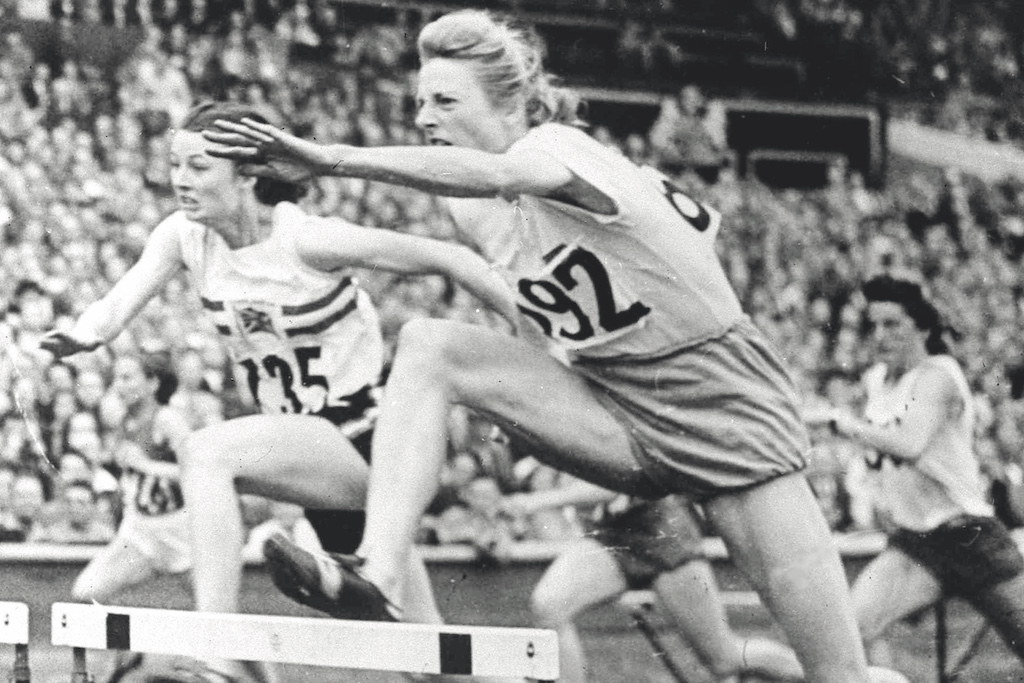Fanny Blankers-Koen: The Olympian Who Changed the Face of Athletics for Women
Jumping over hurdles and smashing through barriers of athletics and gender...
This post may contain affiliate links. Learn more
Fanny Blankers-Koen smashed the boundaries of athletics and gender, says Sebastian Coe

Mandatory Credit: Photo by Anonymous/AP/REX/Shutterstock (7404466a)
Fanny Blankers-Koen of Holland, leaps the last hurdle in the 80-meter hurdles final during the Olympic Games at Wembley Stadium in London
Changing Perceptions of Women in Sport
So far, our gamechangers have been men and, although they all made unique contributions to the shape of modern sport, they were not sportsmen of any great achievement. Our gamechanger this month is a woman and, arguably, athletics’ most iconic female.
Dutch athlete Francina ‘Fanny’ Blankers-Koen not only left the London Olympic games of 1948 with four gold medals over sprint distances including the relay, she also left behind the nostrum of the age, that women were neither physically or mentally wired to break into that male dominated preserve. It is as much for that achievement that Blankers-Koen makes it into our list of sporting buccaneers.
By the time she arrived in London, she was already 30 years of age and a mother of two children. Although relatively unknown to the British public, at the age of 18, she competed at the 1936 games in Berlin. If Jesse Owens (she got his autograph) will forever be synonymous with those games that were as much a platform for Nazi Germany as for Olympism, Blankers-Koen will forever be remembered for her Herculean performances on the cinder track in the old Wembley stadium.
If the track surface was of another age, her London accommodation was basic. I recall being told by one of her Dutch team-mates at Blankers-Koen’s funeral in 2004, that six of them shared a room at an orphanage in Wembley. All a far cry 64 years later from the purpose-built village for London 2012 athletes.
She came to London the holder of six world records and two European championship golds in Oslo two years earlier. However, despite her pedigree, her biggest challenges were the prevailing social and cultural norms of the time.
Defying Expectations
Not helped by the British Athletics’ team manager, Jack Crump who questioned, in print, whether a 30-year old mother of two was really a credible competitor. Understandably, he proved to be the spur she needed. Although later in life the pair became good friends, often joking about the affect his words had on her races.
In the 100-metres, she crossed the line with a winning margin, in the mud, by three yards. Later that week she scooped up the 80-metre hurdles, 200-metres and, for good measure, in the relays took her team from third to pole position on the final leg.
Only the rules at the time prevented her from almost certainly winning the long jump and probably the high jump too. By the time she left London, she had become athletics’ first global female superstar and paved the way for other women athletes like Irena Szewińska from Poland, Americans Wilma Rudolph and Wyomia Tyus and Betty Cuthbert from Australia.
She went on to win three further European titles in 1950, another Olympic games appearance in Helsinki, retiring shortly afterwards. After her competitive career, she led the Dutch team as team manager in the 1960, 64 and 68 Olympics.
In 2007, three years after her death, I was honoured to unveil an imposing two-metre high bronze statue at the track in Hengelo. She didn’t enter the sport with an ambition to further the cause of gender equality but I can think of few women in sport that have done more to change that very perception.
